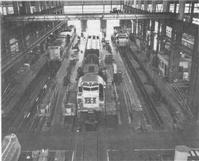


Chapter 6
I Construction During The Settlement Years
II The Use Of Timber As A Structural Material
III Structural Steel
IV Concrete Technology
V Housing
VI Industrialised Pre-cast Concrete Housing
VII Ports And Harbours
VIII Roads
IX Heavy Foundations
X Bridges
XI Sewerage
XII Water Engineering
XIII Railways
i Factors Impeding Developments
ii Railway Sleepers
iii Rail Tracks
iv Some Interesting Railway Projects
v Tarcoola-Alice Springs Railway
vi The Conversion to Standard Gauge
vii Railways in the Pilbara
viii Railways in the Coal Fields of Queensland
ix The Melbourne Underground Railway Loop
XIV Major Buildings
XV Airports
XVI Thermal Power Stations
XVII Materials Handling
XVIII Oil Industry
XIX The Snowy Mountains Scheme
XX The Sydney Opera House
XXI The Sydney Harbour Bridge
XXII Hamersley Iron
XXIII North West Shelf
Sources and References
Index
Search
Help
Contact us

Railways in the Pilbara
The Hamersley Iron project (see p. 376) has been described as 'an efficient heavy railway system with a mine at one end and a port-handling facility at the other'. Indeed it was the necessity of handling, at economic rates, large volumes of iron ore across rugged country in the harsh hot dry climate which was responsible for the application of such significant human resources, to the research, design, construction, maintenance and operation of the railway systems. Fig. 46 illustrates the railway workshop at Hamersley Iron.
Initially, in the early 1960s, much of the technology was acquired from the U.S.A., but with experience and local research, Australian engineers in the 1980s introduced technology which established them as world leaders in the state of the art in the field of heavy railway engineering. The first Heavy Haul Railways Conference held in Perth in 1978, attracted world-wide interest and confirmed the pre-eminence of Australian engineers. The Hamersley Iron and Mt. Newman projects each handle approximately 50 mtpa which, between them, represents a gross tonnage equivalent to the combined capacity of all other railways in Australia. The significant developments have been in the size of the motive power units, train lengths, axle weights and quality of the tracks.
Organisations in Australian Science at Work - Hamersley Iron
People in Bright Sparcs - Connell, J. W.
 |
Australian Academy of Technological Sciences and Engineering |  |
© 1988 Print Edition page 380, Online Edition 2000
Published by Australian Science and Technology Heritage Centre, using the Web Academic Resource Publisher
http://www.austehc.unimelb.edu.au/tia/381.html